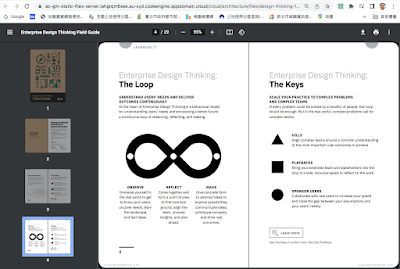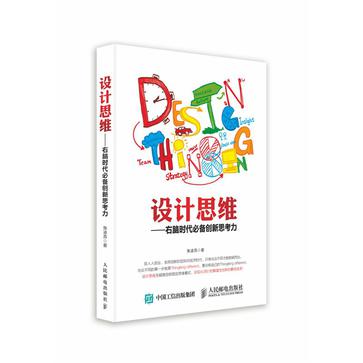| 設計思考 | ||
| 新聞 | ||
新北、輔大簽署課程合作備忘錄高中生可跨域選讀 - Yahoo奇摩新聞 ... 大學簽署課程合作備忘錄,結合民生學院、織品學院、 | ||
新北、輔大簽署課程合作備忘錄高中生可跨域選讀 - 聯合報 新北市府今天與輔仁大學簽署課程合作備忘錄,結合民生學院、 | ||
新北教育局攜手輔仁大學共同簽署課程合作備忘錄打造高中民生食安 ... 設計思考、創意發想、運動議題的跨域人才。 廣告(請繼續閱讀本文). 廣告 ... 此外,為培育創新跨域人才,在設計思考與創意發想的課程設計結合 |
設計巧思力學實驗室
DesignThinkology Lab:這是一個應用設計思考的創新與創造力;試圖來解決“人類”複雜問題的教學研究與案例分享的搜集和一些紀錄
2024年3月23日 星期六
2024.3.24 DT's G news in Taiwan
2023年6月13日 星期二
Infinity sign 永續循環的符號都差不多,用在ESG,Design Thinking 上,還有嗎?
看到網路上這篇打書寫著
企業ESG永續實戰攻略 創新的本質:解決問題還是實現理想?|ESG書選(下)
作者:田瀨和夫(Kazuo Tase)出版社:商業周刊 出版日期:2022/04/20
IBM 很早就把他們自己認為符合IBM 企業發展的 Design Thinking 的所有培訓教材影片與獲得的標章專業等級幾乎做的完美連教材的版型
都是讓你登錄帳號有時間有能力看的懂英文就可以獲的
但若不是懂設計思考或是接觸過
要懂IBM Enterprise Design Thinking 的邏輯
還是需要一點時間
我猜也是沒幾個人會去拿他們的標章的原因(六種標章意義都不同各自有定義 關關都不同 不是每個人都要集滿六種)
無獨有偶 這無限大循環的圖像就被視覺設計師拿來變化一下了
當然還是會有不同的顏色和細節
但圖像要表達的好像都是差不多的
但講的是不同樣的事
IBM 裡的設計思考-循環 是指understand users' needs and deliver outcomes continuously
了解用戶需求並持續交付成果
有三個重要的循環節點(如下圖)
- observe
- reflect
- make
所以要表達永續 循環 就只有用這個符號了嗎?
設計師是創作者還需要多多的想像一下啊!
設計思考在大學的商管系中只不過是個課
 |
白髮老人(有位老師在LINE的校友的群組裡跟我對話時,他虧我的別稱(只因為我看到台大新的課程(課程名稱是有關創新創業的在捷運車站裡打廣告,我拍下來傳傳到群組,諷刺的說 同樣都是拖鞋 角度不一樣機會就是不一樣的例子,話說校方同年把創創所就是要廢除)
所以白髮老人就是要憶當年一下
楊老先生2010念的就是這個當時創新的EMBA
叫做企業創新與創業管理研究所
簡稱創創所
剛剛仔細的在網路上搜了一下(下圖)
當時第一名考進來的白髮老人(最後多念一年最後才畢業)
竟然在江湖上還殘有補習班出版書的紀錄(可能當時進這裡還真的有人補習考試)
真假
我記得有147人還是146人去考
不過那時候是過兩關
一關是書面審查
一關是筆試(我不知道筆試有這麼多人考 考場場面盛大啊!)
那這跟設計思考有什麼關係
因為這是跟學校將設計思考的課程關掉的速度與創創所結束的速度 一樣快
因為這是跟學校將設計思考的課程關掉的速度與創創所結束的速度 一樣快
所以有關
應該說
主觀的認為設計思考在管理學院也只就是個思考(管理學院的教務長跟我說的)
沒啥明確指標
用兼任的角度與現任校長(20年前當時是我領隊去上海參訪中國浦東的校長特助(教授))老客戶與長官問候順便帶出系上的問題
這樣有越權?只能道歉再道歉(但我心裡想 我有不是該校聘任的搞的全管院都認識我了?!我就是沒按行政流程上報,這是種朝廷的文化)反正得罪了一堆老師(管理學院老師都認識我了),然後過來跟我說 不要這樣 (我只是跟老長官 說說現在的我 感到怎樣罷了
為此
我影響到推薦我進實踐的老師( 他擔心也預言我將會被裁掉的命運,也說我越權,但是我用傭兵的POV 告訴老師 說 我若是編制裡的老師,我絕對不會這樣做 但可惜的是我不是員工
我們傭兵(指兼任老師)
大學法也沒有規定或法律不準我跟校長聯繫吧
反正就是我也是有錯
沒有看仔細
學校內部鼓勵課程創新的方案 (創新教案不是要你寫新的案而是你把舊的教案如何精進化)
我以為是提新的教案
所以我也道歉了
教務長人很好(後來他也有問我,也是我成大的老學長)但他完全不懂設計思考
還說若不是我去找他 他可能就要裁掉了(其實我本來也沒有要去找他)
這樣ㄧ吵果然有糖吃了
給我剩下時間的助教費(我只記得只夠付12週)
還有教材費(沒到我口袋,我發給學生作小組當作議題的競賽獎金了兩班都一樣)
也歡迎我加入 管理學院的教研的小組 (因為我用心智圖做了一個為學校建立 一個創意引導師的青年證照- 讓大學生在企業都能主持腦力激盪與創意思考會議的小組領導幹部)
有位老師還勸我不要擋別人的官途
其實我自認為我們傭兵 沒有這麼大影響力
原因是我為了學校
寫了一個計畫 (只有mind map)
有關跨學科學習的培訓(上面有寫)
說實在的 我們傭兵真的也沒空理這位老師
反正白老鼠又不是當第一次
教育部有太多學程結束
是沒有績效
看不到未來的
但還是有學分或學位的
只是我這次是實驗方的打手 (指教設計思考的課程)
白老鼠是學生 (我不認為這些被我教過的學生是白老鼠-除非這些學生翹課太多次才會沒學到東西)
很多老外的東西來到台灣都是水土不服的(設計思考)
但台大還是成立的創新學院 (看到學院簡介 也是創創.......同樣都是創創 命運不一樣 但好幾年前相關學程也是遭停招的命運)
教育部辦的苗圃計畫也是在教老師學習跨域創新教學也是用設計思考
參加許多次的初階工作坊
但我覺得老師很用力在教
教育部不知道在做什麼
可能是摳摳搞不定吧(執政黨的猶豫不決)
我想針對高中以下的課程推廣(教育部是有保留的)
因為不是升學的課程(會考與學測又不考設計思考)
應該台灣不多的人是從碩士念創意思考研究到博士是研究設計思考的文創又是白髮老人 阿伯級的人吧
繼續奮鬥吧
就當作設計思考也不過是人類的一種思考吧
從小我不是一個輕言就放棄的人
但隨著年紀愈大 現實面的年邁父母的照顧 未完成的博士學位 生活成本開銷 幾家未確認還要不要經營的公司......一堆鳥事
2023年3月7日 星期二
2023年2月28日 星期二
2022年11月3日 星期四
到2022年美國的設計思考相關的認證與訓練營
- Coursera Design Thinking courses
- Darden Executive Education and Lifelong Learning Certificate in Design Thinking
- eCornell University Design Thinking certificate
- EdX RIT MicroMasters Program in Design Thinking
- Global Knowledge Design Thinking Boot Camp
- IBM Enterprise Design Thinking training
- IDEO U Foundations in Design Thinking certificate
- Innovation Learning Innovation & Design Thinking Facilitator Program
- MIT Sloan Executive Education Mastering Design Thinking
- Stanford University Design Thinking Bootcamp 最貴的課程1,4000元美金差不多要448,000 台幣
2022年7月31日 星期日
台灣設計思考可以再進步的地方-教學材料硬體設施的問題?
在設計思考的步驟中:
我個人的教學經驗
其實定義問題是最困難的
雖然每年都有政府輔助青少年的設計思考培訓可以看到還是由台大來負責執行
我個人覺得
推廣設計思考向下紮根的教學案
還是僅停留在某幾個國立的學校裡
天龍國果然幸福可以擁有國內最完整也是最大的教育機構台大社團來搞這麼大的活動
非常樂見其成
不過
上面這本書設計思考工具箱英文版一上市 剛好我在LInkedin 認識其中的一位作者時 我再出版後約一個多月在雅馬遜上就買了原文的
這本書介紹是六大步驟
幾年前推廣的普遍五大步驟
是不同的流程
不過作者有給我建議 不用太在乎 五個或六個流程
重要是思考的發散收斂與CPS (creative problem solving)
但以我在大學教大一新生的經驗中
的確
使用新的六大步驟
同理心拆開變成
明了與觀察作為第一步第二步
學生的反應有明顯的差異
與提早知道定義問題的困難處
當精實創業碰到設計思考時Lean Startup Meets Design Thinking
google 找了兩個大咖 Tim Brown 和 精實創業Lean Srartup的作者
來分享兩者之間的同異
我也在
大陸的出版的書中
找到一本
是我最近看到有關講設計思考
最好看的一本
我有買回家
作者張凌燕
本來覺得封面設計 好像比較插畫一點
仔細一看
哇 這是我看過關於講設計思考design thinking寫的最棒的一本(2018的時候)
Lean Start up 的重點是
- MVP (minimal viable product )
- core is 建構---評估---學習 的循環
作者最後講到台灣的案例
其中有家公司叫
http://www.pebbo.co/
最後最先搞design thinking學位d.school 的 stanford 也有教授拿來比較可以參考看看
2022年3月30日 星期三
Experiencing emotions in design thinking: How positive and negative affects play their part in the innovation process
Experiencing emotions in design thinking: How positive and negative affects play their part in the innovation process
T Utriainen, L Valtonen - CERN IdeaSquare Journal of Experimental Innovation, 2022
… This study analyzes design thinking teams' self-reported emotional states and
explores the emotional spectrum associated with various innovation activities. The
Geneva Emotion Wheel instrument is used to map relations between 20 emotions …
explores the emotional spectrum associated with various innovation activities. The
Geneva Emotion Wheel instrument is used to map relations between 20 emotions …
2020年7月16日 星期四
from one of The DT playbook Author Patrick Link answer
david asking : If I will teach in the coming semester for freshman in admin. college in the university, there have two hours per week and 18 weeks times to coteach young guys, what kind module will suggested, 5 ideo or ur 7 phrases?
Patrick Link:
I think whatever 5, 67 processing, we must depend the TA what we teach or mentor or coach.
I think whatever 5, 67 processing, we must depend the TA what we teach or mentor or coach.
D.T. tool let innovating facilitator easy to explain complex processing and simple visual using.
I try to use Chinese/English to help Teacher to understand 50 DT creativity tools
First, as the teacher, we must know ur student's learning strategy and goal, for example, we teaching the freshmen in managing college we just teach DT to Test! As when we arranging and planning the 18 weeks syllabus structure, tell the truth if u are also fresh lector, you never know what are your client level? It's mean their are so many client or student factors, only know their are "pro-high school graduate student".
I would recommend to do at least 3 iterations.
1. understand the problem
2. reframe the problem and first idea
3. obtain problem solution fit and create the lean canvas
訂閱:
文章 (Atom)





